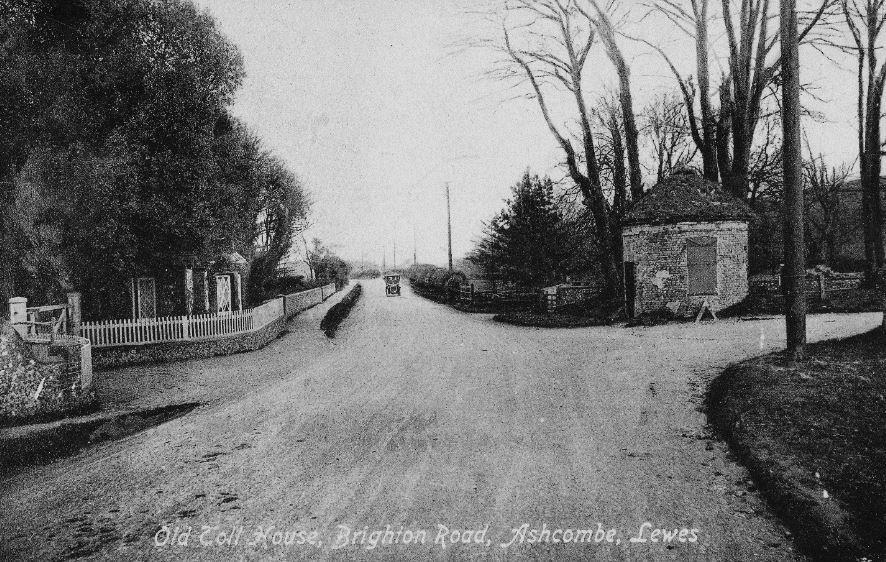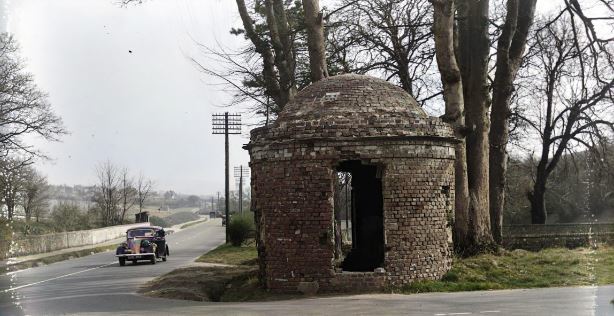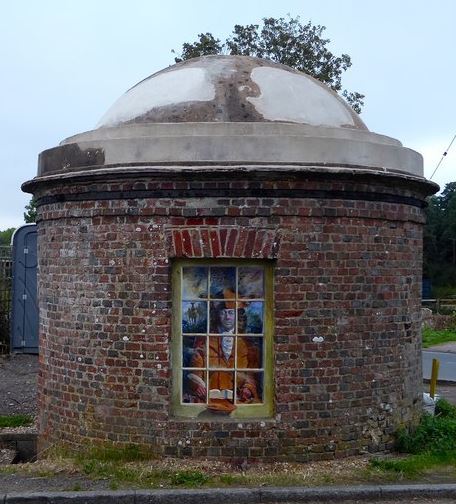Ashcombe Hollow #3: The Toll House

The cache, a camo-taped preform tube, is hidden within 100m of this curious structure with a fascinating history and located at the published coordinates. Parking is available nearby either (with care) at the roadside or in extensive adjacent parking areas. Public transport is also available on buses 28 and 29 to Brighton from outside Lewes Waitrose or Post Office.
The cache became possible with the 8/2/22 archiving of LingAyFamily's GC38G3P The Lewes Tollgate which was hidden on 28/11/11 garnering some 22 finds and 3 FPs during its over 10 year existence. I had DNF'd it in September 2021, presumably just before the required info subsequently disappeared.
To find the cache, you will need to collect the following information from the script of The Brighton & Lewes Turnpike Trust Order which is painted on the eastern wall panel:
1. The date at the top of the panel is 17A0
2. The toll for an unladen ox which is not drawing = B d
3. The toll for a mule pulling a waggon cart with wheels of breadth under 6 inches = C d
4. The toll for each score of a drove of sheep = D d
5. The toll for two bullocks drawing any other carriage = E d
The cache is hidden at:
N 50 51.E(B+C)(D-B) W 0 1.D(A-4)(Bx2)


Although it may have the appearance of some kind of lock-up, this unusual Grade II listed round building is a relic and reminder of the former turnpike system of road provision and maintenance, supported by tolls payable by the road user.

Located at what was the old junction of the A27 and Ashcombe Hollow, it is the sole survivor of a pair of toll cottages/houses on either side of the eastern start/end of the Brighton-Lewes turnpike. From its original line the A27 was moved a few metres north and the latter lane was blocked off and in 1976 a new route made to take the lane 300m to the east parallel to the A27 to Ashcombe (Farm) roundabout. Owned by Sussex Heritage Trust since 2001, it is a domed, circular building, 10ft high and 15ft in diameter, with a vaulted brick roof.

The history of the toll house is of interest to young and old alike, as it yields an insight to travel in a bygone age. Built in 1820, it was originally used as a bakehouse, store and shelter for road maintenance as well as for the collection of tolls. A larger Toll House sited on the north side of the road provided accommodation for the turnpike keeper and his family. This was demolished around 1868 and the remains finally lost to the various road widening scheme which now see a major dual carriageway over the site.

The Lewes & Brighthelmston [the old name for Brighton] Turnpike trust was established to collect tolls for 8 miles of this turnpike by An Act for more effectually repairing the Road from Lewes to Brighthelmston in the County of Sussex [6th May 1833] which stated . . .
'Tolls to be paid but once a day at same Gate for Horses etc. not drawing, but a fresh Toll to be paid every Third time of passing for Horses, etc drawing. Two full tolls only to be taken on the same Day for passing through all the Gates on the Road. Money not to be expended in repairing Streets'.

The road was de-turnpiked in about 1871 when the trust was wound up.
The trusts were bodies set up by individual acts of Parliament, with powers to collect road tolls for maintaining the principal roads in Britain from the 17th but especially during the 18th and 19th centuries.
At the peak, in the 1830s, over 1,000 trusts administered around 30,000 miles (48,000 km) of turnpike road in England and Wales, taking tolls at almost 8,000 toll-gates and side-bars (see here for a detailed list). The turnpikes and tolls caused considerable local resentment which led sometimes to violent opposition.
 There is a door on the northern side of the toll house which is currently used for storage, and inside are the remains of a fireplace and an oven. There used to be two windows either side of the door which were blocked by the county council at the same time as iron strapping was installed for strengthening the structure. This repair work was done despite ambiguity over ownership which was resolved by the Sussex Heritage Trust who laid legal claim to it and took possession of it on 1 May 1989. It remains their property as no-one has yet come forward to contest it.
There is a door on the northern side of the toll house which is currently used for storage, and inside are the remains of a fireplace and an oven. There used to be two windows either side of the door which were blocked by the county council at the same time as iron strapping was installed for strengthening the structure. This repair work was done despite ambiguity over ownership which was resolved by the Sussex Heritage Trust who laid legal claim to it and took possession of it on 1 May 1989. It remains their property as no-one has yet come forward to contest it.
Research undertaken by the trust and others, indicates that the building was probably used as a Turnpike Lengthsman's hut. Aka pikeman, this was the person responsible for operating the turnpike.
The roof was formerly a tidy hemisphere with specially shaped bricks which were sadly stolen in the 1940s before East Sussex County Council restored it in the 1950s. The mural over one of the old window spaces was added more recently.
before East Sussex County Council restored it in the 1950s. The mural over one of the old window spaces was added more recently.
The fascinating 1949 piece Sussex Turnpike Anecdotes starts as follows:
TURNPIKES! There is a certain sturdy opposition about that word; yet few of the present generation know that turnpikes, or turnpike-gates, were really tollgates erected across roads to prevent the progress of travellers until they had paid dues for the maintenance of the highway. When the worthy pikemen had collected their money, the gate was swung open and they journeyed on— only to be barred by further gates at frequent points down the road !
What impediments these gates must have been ! Runaway lovers with irate fathers in pursuit; criminals escaping from Bow Street Runners—and the Runners themselves; shepherds with their flocks; farmers going to market; "nobility and gentry" in their carriages; gentlemen on "King's Business"—and maybe " gentlemen" on "King's Business" of another kind with a keg or two of smuggled brandy hidden under a load of hay!; commercial travellers or "bagmen"; highwaymen (who sometimes urged their horses to leap the gate) and, above all, vehicles—curricles, gigs, carriages, phaetons, drays, victorias, flys, waggons, traps and, by no means last, stage-coaches all had to stop at the turnpike-gates. True, certain types of travellers and vehicles were exempt from paying toll, but even they had to wait for the pikemen to open the gate.
